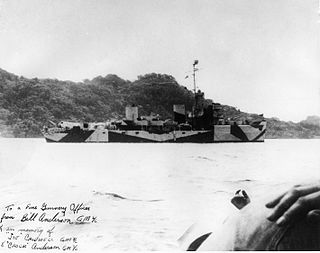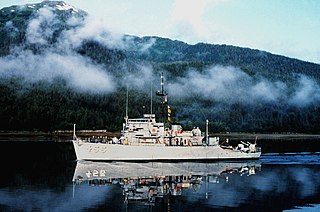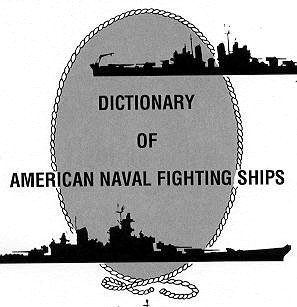Related Research Articles

A minesweeper is a small naval warship designed to engage in minesweeping. Using various mechanisms intended to counter the threat posed by naval mines, waterways are kept clear for safe shipping.
HMAS Curlew was a Ton-class minesweeper operated by the Royal Navy from 1953 to 1961, and the Royal Australian Navy from 1962 to 1991. During her Australian service, the ship operated off Malaysia during the Indonesia–Malaysia confrontation during the mid-1960s, then was modified for use as a minehunter. Delays in bringing a replacement class into service kept Curlew operational until 1990, and she was sold into civilian service in 1991.

The Admirable class was one of the largest and most successful classes of minesweepers ordered by the United States Navy during World War II. Typically, minesweepers detected and removed naval mines before the rest of the fleet arrived, thereby ensuring safe passage for the larger ships. They were also charged with anti-submarine warfare (ASW) duties with rear-mounted depth charge racks and a forward-firing Hedgehog antisubmarine mortar. Their job was essential to the safety and success of U.S. naval operations during World War II and the Korean War. These minesweepers were also employed as patrol vessel and convoy escorts.

The Bangor-class minesweepers were a class of warships operated by the Royal Navy (RN), Royal Canadian Navy (RCN), Imperial Japanese Navy (IJN), and Royal Indian Navy (RIN) during the Second World War.

The Ton class were coastal minesweepers built in the 1950s for the Royal Navy, but also used by other navies such as the South African Navy and the Royal Australian Navy. They were intended to meet the threat of seabed mines laid in shallow coastal waters, rivers, ports and harbours, a task for which the existing ocean-going minesweepers of the Algerine-class were not suited.
USS Pigeon (AM-374) was an Auk-class minesweeper acquired by the United States Navy for the dangerous task of removing mines from minefields laid in the water to prevent ships from passing.

The Lapwing-class minesweeper, often called the Bird class, was an early "AM-type" oceangoing minesweeper of the United States Navy. Seven ships of the class were commissioned during World War I, and served well into the 1950s. A number were refitted to serve as ocean-going tugs, salvage vessels, seaplane tenders, or submarine rescue ships.

USS Velocity (AM-128) was an Auk-class minesweeper acquired by the United States Navy for the dangerous task of removing mines from minefields laid in the water to prevent ships from passing. She was the second warship to bear the name.

USS Swerve (AM-121) was an Auk-class minesweeper acquired by the United States Navy for the dangerous task of removing mines from minefields laid in the water to prevent ships from passing.

USS Salute (AM-294), was a U.S. Navy oceangoing minesweeper, laid down on 11 November 1942 by Winslow Marine Railway and Shipbuilding Co., Seattle, Washington; launched on 6 February 1943; sponsored by Miss Patricia Lindgren; and commissioned on 4 December 1943, Lt. R. H. Nelson in command.

USS Implicit (AM-455/MSO-455) was an Agile-class minesweeper acquired by the U.S. Navy for the task of removing mines that had been placed in the water to prevent the safe passage of ships.

USS Notable (AM-460/MSO-460) was an Aggressive-class minesweeper acquired by the U.S. Navy for the task of removing mines that had been placed in the water to prevent the safe passage of ships.
USS Stalwart (AM-493/MSO-493) was an Aggressive-class minesweeper acquired by the U.S. Navy for the task of removing mines that had been placed in the water to prevent the safe passage of ships.

USS Venture (AM-496/MSO-496) was an Aggressive-class minesweeper acquired by the U.S. Navy for the task of removing mines that had been placed in the water to prevent the safe passage of ships.

EMLKalev (M414) was a Frauenlob-class minesweeper of the Estonian Navy, which belonged to the Mineships Division.

The Rizal class is a ship class of two patrol corvettes currently in service of the Philippine Navy, and are currently its largest class of corvettes. These ships were formerly used by the US Navy as Auk class minesweepers. Under the Philippine Navy, the two vessels have undergone upgrades and modification, and were categorized as corvettes.

Project Hula was a program during World War II in which the United States transferred naval vessels to the Soviet Union in anticipation of the Soviets eventually joining the war against Japan, specifically in preparation for planned Soviet invasions of southern Sakhalin and the Kuril islands. Based at Cold Bay in the Territory of Alaska, the project was active during the spring and summer of 1945. It was the largest and most ambitious transfer program of World War II.
HMCS Noranda was a Canadian Bangor-class minesweeper built for the Royal Canadian Navy in 1940. She was launched on 13 June 1941 and escorted convoys for the rest of the war. After the war the minesweeper was refitted and was transferred to the Royal Canadian Mounted Police as Irvine. In 1962, the ship was sold and was turned into the yacht Miriana. Renamed Marijana and Viking L&R in 1969, the yacht sank in May 1971 off the coast of Jamaica.

HNLMS Onverschrokken (A856), also known as HNLMS Mercuur (A856), was an ocean minesweeper of the Royal Netherlands Navy. Between 1954 and 1965 she was mainly used to clean up a huge amount of explosives and mines that had ended up in the sea during the Second World War. Later, in 1973 she was renamed as HNLMS Mercuur (A856) and used as submarine support ship till her decommissioning in 1987. Nowadays, she is a museum ship that can be visited in Vlissingen.
References
This article incorporates text from the public domain Dictionary of American Naval Fighting Ships .
The public domain consists of all the creative works to which no exclusive intellectual property rights apply. Those rights may have expired, been forfeited, expressly waived, or may be inapplicable.

The Dictionary of American Naval Fighting Ships (DANFS) is the official reference work for the basic facts about ships used by the United States Navy.